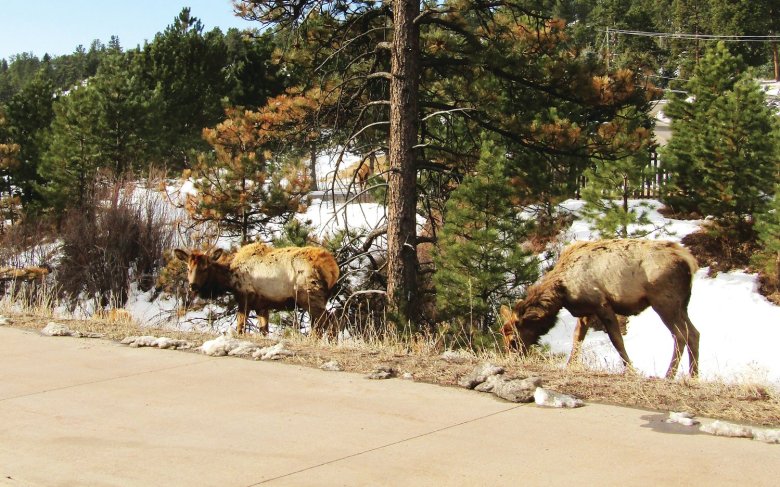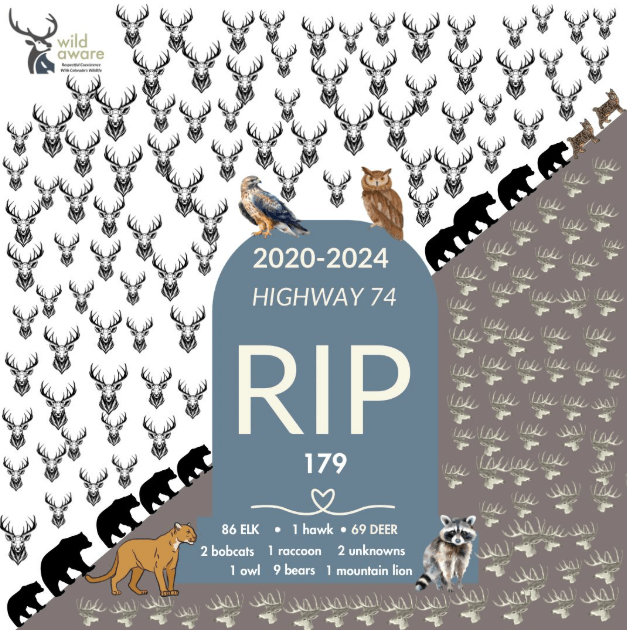In four years, about 180 wild animals lost their lives on Highway 74 near Evergreen, among them 86 elk and 69 deer. And those only include the bodies reported between 2020 and 2024 by or to the Colorado Department of Transportation.
“It’s common that for every road kill animal, there are another one to five not reported,” said Christie Greene, president of Wild Aware, a group dedicated to mitigating such collisions in the Evergreen area. “Because Evergreen Parkway is so visible, I would bet our ratio is more like one to one.”
Most of the area’s animals are struck by vehicles along the stretch of Highway 74 between Interstate 70 and Evergreen Lake. The numbers do not include livestock or pets.
Colorado State Patrol crash data, which is kept separately from the Colorado Department of Transportation’s data, recorded 646 wildlife-vehicle collisions on Jefferson County roads between 2015-2019. That made Jeffco the county with the second-highest number of wildlife-vehicle collisions. It trails only Douglas County.
30 seconds of open highway
Colorado 74 is particularly tough for animals because of the high level of traffic and lack of wildlife crossings.
“We cannot have a wildlife overpass or underpass on Highway 74 because of land use and ownership,” Greene said. “There is no public land. There’s county open space, Denver Mountain Parks and Jefferson County open space. On either side of any of that are homes and businesses.”

Making it even tougher, an animal needs 30 seconds of open highway to safely cross.
“If the average daily traffic is 10,000 cars, it acts as a complete barrier for them,” Greene said. “The average daily traffic at Lewis Ridge is 22,000 to 23,000 cars. That’s twice as many cars as is considered a physical barrier for an animal.”
Greene said early summer is the most potentially deadly time of year for area wildlife, and when drivers should be particularly attentive.
“June and July are tough up here because of calving season,” she said. “You’ve got bands of elk cows and calves going back and forth across the road.”
Wild Aware recently partnered with the Colorado State Patrol for wildlife/vehicle collision month. CSP has focused its social media on the message, ‘Give us a brake,’ which urges drivers not to honk at wildlife, but to instead flash your high beams, turn on your hazard lights and wait.
“Animals are unpredictable, so you don’t know what honking is going to make an animal do,” Greene said. “By flashing your lights, you’re warning people that something is ahead. If you come up on animals, use your best judgment. You may need to pull over on the shoulder and wait.”
That can require time and patience.
“Because they go in little groups, they can take 20-30 minutes to cross,” Greene said. “You could go between little groups very, very slowly.”
Greene said animals that are struck by vehicles and killed are not always accounted for, in part because people may not make a report, the animal may run or walk off the road and die elsewhere and because some drivers may take the carcass home.
“You can count road kill, but miss counting animals who were picked up by people who want to bring them home or eat them,” she said.
It’s legal but requires a permit from Colorado Parks and Wildlife.
For more information on their efforts to protect wildlife, visit Wild Aware.

